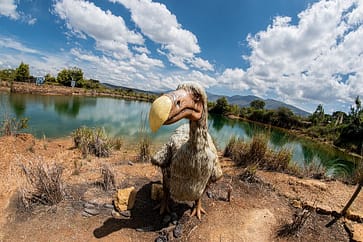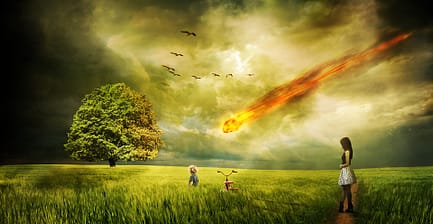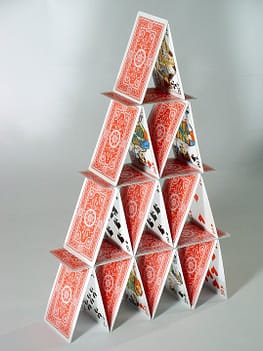Or How Do You Solve A Problem Like Extinction?
The hills are alive with the sound of nature… though not for long if we have anything to do with it! Well that went downhill fast… quick, look at this sleeping baby orangutan! … Ahhh… thank GOODNESS for the enduring existence of cute animals… DAMMIT!
I know, it sounds awfully dramatic, doesn’t it, but unfortunately it’s true. We humans are currently in the process of causing the imminent, sixth mass extinction of life on Earth. However, the human-induced, or Anthropogenic, extinction of life isn’t anything new. In fact, we’ve been at it for hundreds if not thousands of years.

From the Woolly Mammoth (10,000 years ago) and the Dodo (17th Century) right through to the Western Black Rhinoceros (2011), Pinta Island Tortoise (2012) and Indefatigable Galapagos Mouse, countless species have gone extinct at our hands…
.. Well, except the Indefatigable Galapagos Mouse which, after a tireless fight, finally succumbed to exhaustion in 2017…
.. Not really, that was us too.
The point is, our talent for extinction runs deep. It’s even given rise to colloquialisms like ‘as dead as a Dodo’ and ‘as non-existent as the Gastric Brooding Frog”, but let’s not get hung up on the failings of previous generations or questionable turns of phrase.
After all, you and I didn’t chase herds of giant, furry elephants off cliff tops. However, it’s now clear that we are part of a much bigger extinction picture… and its rate is accelerating.
A Change Of Pace

Without extreme, external forces, extinction rates maintain a level 1 per every million species, per year.
Such periods of stability, as seen during our time, the Holocene, give life time to adapt to the naturally slow pace of change. As a result, it is thought there are presently between 8 and 10 million species on our planet.
However, introduce an extreme event, say, a massive asteroid strike, and the rapid environmental changes that follow leave life unable to adapt quickly enough. Thus a mass extinction event occurs. Today we are that asteroid.
Now, since the year 1500, 500 species of plants and 700 species of animals have gone extinct. Admittedly, at a glance, this might not seem like much to you and I.
However, when you consider that we’ve now accelerated extinction rates to between 100-1000 species per million, per year, one can’t help but hope Bruce Willis is available to step in and blow up our asteroid. In his absence (he’s too busy filming Die Hard 17.2: Triple Hard Bypass) our unsustainable habits stand to induce the extinction of over 1 million plants and animals. Yipikaye, eh!
Why Should We Care About Extinction?
Well, if the immoral nature of knowingly causing the extinction of over 1 million living things doesn’t instil a sense of responsibility, maybe the fact that we stand to cause our own demise as a consequence will.

Imagine, if you will, a house of cards. We humans are at the pinnacle of the house and the stability of our continued existence relies upon the vast network of biodiversity, or supporting cards, below.
Remove one or two supports and you might just manage to retain some form of recognisable structure. Continue to remove more and more cards, however, and eventually the whole house collapses, bringing the pinnacle crashing down with it.
Similarly, if you stop removing the supporting cards and even work to rebuild and strengthen them, then the pinnacle remains strong.
Fundamentally, then, we humans rely on the natural world for our very existence. The air we breathe, the water we drink and the food we eat all requires a healthy, biodiverse natural world. Even the safety of our homes relies upon a flourishing wilderness!
That isn’t to say that the more beef burgers you eat, the more likely you are to be burgled, rather that we are systematically destroying the structures that keep our society functioning (though don’t get complacent, The Hamburglar’s out there)!
I know it all seems a little farfetched from where we’re sitting in our comfortable, warm homes… but hear me out.
Extinction: Cause And Effect
The Destruction Of Habitat

For starters the trees we tear down and the wetlands we reclaim provide excellent, natural flood defences.
Furthermore, the barren pastures and concrete plains that we lay in their place have a significantly reduced ability to absorb water. Hence, the more we expand and clear, the more likely we are to experience catastrophic flooding.
Likewise, it’s no secret that natural, biodiverse forests are the biggest and best carbon stores we have. Yet currently we clear 3.8 million hectares of wilderness every year. That’s a number so big I can’t even envision it but let me tell you, it’s a lot of football pitches… even more tennis courts… and a gazillion putting greens!
In fact, three quarters of the planet’s terrestrial land has been repurposed just for us. That’s more than enough to meet our needs and yet still we persist. Worryingly, the more we clear, the faster ecosystems collapse and the more severe the threat of mass (and our) extinction.

One particularly sobering consequence of this encroachment into the wild is that it exposes us to new diseases. Untouched forests contain thousands of hitherto unseen viruses.
It’s no surprise, then, that 31% of all emerging diseases come from land use change. No surprise that the current coronavirus pandemic stems from our destructive relationship with nature.
We currently come into contact with 5 new viruses with pandemic potential every year. Fail to change and this number and their strength will increase exponentially.
I don’t know about you but I think Lockdown 77 sounds like a rubbish movie and an even worse reality!
Climate Change
I know, here it is again. What sort of wannabe conservationist would I be if I didn’t mention climate change every now and then, though!? Yup, due to destructive habits like deforestation and our reliance on fossil fuels, we’re currently on track for a 3-4°C rise in global temperatures.
To prevent a sixth mass extinction event, we need to reduce that increase to 1.5 or 2°C at a push. If we fail, millions of species will be lost; we’re already seeing its effects.

Around the world, large mammals, such as Polar Bears, have already disappeared from three-quarters of their former range. At this rate, it’ll soon be uncouth to eat a Glacier Mint!
On top of that, 25% of all plants are set to vanish and over 10% of insects will follow suit. Combined with the effect of pesticides, by the end of the century that number could rise to 100%.
This would be disastrous; not only do insects form the food chain for thousands of other species but they pollinate three-quarters of food crops. Our food crops! So you can kiss goodbye to your morning cereal and your afternoon banana (that’s rude, that is!).
Poaching
Don’t get me wrong, it’s a jolly decent way to cook your eggs but we’re not here to discuss my fondness for runny yolk, rather the illegal practice of slaughtering wildlife for meat, hide, ivory and, well, anything!

We lose up to 96 elephants and 2-3 rhinos every day from poaching. Without urgent intervention elephants could be extinct in the wild in a decade and rhinos, well, the outlook is even worse.
This is due largely to black market ivory and rhino horn trade, the majority of demand for which stems from places like China and Vietnam (though no country is truly absolved).
Here ivory and rhino horn are seen as both a status symbol and medicine, the latter use, of course, being particularly ludicrous; an elephant’s ivory is comprised of dentine and rhino horn of keratin – you’d do just as well snort your own teeth and hair.

Similarly, the most trafficked animal in the world falls victim to the same nonsense. 175k pangolins are poached for their keratin scales every year and of the 8 known species, all are threatened with extinction.
But it doesn’t end there. Whether slaughtering tigers for pelts and pastes, killing sharks for their fins (100,000,000 a year) or removing orchids from the wild for medicine and food, 99.9% of illegal wildlife trade is based on falsehood and all are unsustainable.
Population growth
At current rates, by 2100 there will be 11 billion of us on the planet. Now, it goes without saying that the more of us there are, the more we consume. However, it is the manner in which we consume that is most pressing. With that in mind, developed countries consume the most and thus leave a bigger impact on the environment.

For example, the average person in the UK consumes 4 times as much as in India. Likewise, the average person in the US consumes 7 times more.
This is a problem because many of the products we use deliver pollutants into the environment, driving biodiversity loss further. From phones to food, almost everything we have comes with an invisible price.
However, there is a chance for redemption. Around the world, scientists unilaterally agree that if we are to save ourselves and millions of other species, then the moment to do so is now.
What Can We All Do?

To start with governments must act. A new set of global standards must be introduced. Legislation and investment that is eco-friendly and sustainable.
Not only would this be good for the environment but it’s also a powerful way out of the current recession. Train and employ people to retrofit cities and towns to increase their energy efficiency.
Install and maintain sustainable energy sources like solar and wind farms to ring in a new dawn of clean energy. All of these require maintenance and all of these will create jobs.
Equally, we need to stop clearing land. Instead, we must reduce the land we use to farm livestock, implementing much more efficient, plant-based techniques. Do this and we can then employ an army of tree-planters to re-wild the vacated land. Creating new, wild forests will help hoover up to two-thirds of the carbon we’ve already released and bolster biodiversity.
What Can You Do About Extinction?
Happily, there are lots of things you and I can do to help nip this mass extinction in the bud.
- Be more diligent about what and how we consume: As you breeze around the supermarket or through the shopping mall, keep an eye out for particular signs and symbols that let you know a product has been sourced sustainably such as: Marine Stewardship Council (MSC), The Forest Stewardship Council (FSC) and COSMOS.
- Eat less meat and dairy: That isn’t to say stop consuming meat and dairy entirely but a reduction in the amount we eat would help reduce our greenhouse emissions greatly.

- Don’t waste: The food, energy, water and products we waste are huge contributors to our environmental woes.
Waste food releases methane which contributes to global warming, wasted energy requires more to be generated to replace it, wasted fresh water takes a long time to reenter the cycle and requires more energy to clean it, and general waste pollutes the environment.
Plus reducing material waste saves us from wasting money to replace it. Saving the planet = saving money!
- Sign up to a sustainable energy supplier: Yes energy companies that produce entirely sustainable electricity are hard to come by but even switching to one that uses more renewable sources than your current provider can help – might just save you some money too!

- Make your home energy efficient: Insulate your walls, gets some double glazing, get a smart meter fitted and even some solar panels on your roof.
The price of energy efficiency has dropped dramatically since its introduction and if you do your research, you might just find some government funding!
This one could also save you money as those with solar panels often capture too much energy. Hence, they’re able to sell the excess back to the national grid!
- Lobby your government: Sign petitions, write letters and let your government know that you want and expect change. Our lives and the lives of a million other species depend on it!
Making The Choice
All in all the Anthropocene Extinction doesn’t have to be inevitable… it nearly is… but not quite. At the moment, we still have a choice. We can choose to heal the living world and in it, our future, or we can continue our destructive habits and allow catastrophe to spiral out of control. The choice seems obvious to me. If you make it, I and the Pangolins, will thank you.
Have a good one!



